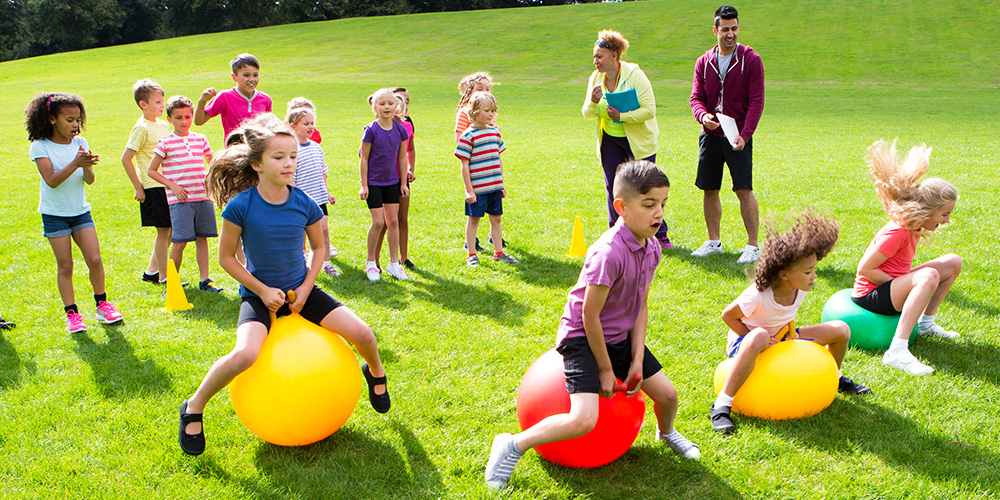Ah, field day. The day when races, both sack and three-legged, take over your school’s lawn and gym. For students, field day means a whole day of getting out of the classroom and having fun. But for you, this event requires lots of planning, preparation, and dipping into the classroom budget.
In this guide, we’ll go over the must-have equipment for a great field day, plus game ideas and advice for accommodating students with special needs.
Field Day Must-Haves
Every field day is different. The ages of your students, whether you’re inside or outside, your school’s safety policies, and many other factors will impact what kinds of supplies you’ll need. As you map out which activities you plan to do, it’s useful to think through what equipment you’ll need and create a master list for the day. Here are a few essentials to get you started:
- First aid kit: Scrapes, falls, knocked heads, and other accidents are inevitable on field day. Keep your kids in the game and save the school nurse some time by having a first aid kit on hand for minor incidents.
- Water: Staying hydrated is essential for your athletes’ performance, so make sure to have coolers full of water bottles stationed around the field.
- Umbrellas: Umbrellas are great to have available whether you’re expecting a little bit of rain or what to give your students and volunteers a chance to escape the sun.
- Sunscreen: In all the excitement of the day, it can be easy for forget sunscreen. As with water bottles, make sure to spread bottles of sunscreen across the field so students can reapply between games.
- Traffic cones: There’s no end of uses for traffic cones on field day. Whether you’re marking off areas of play, creating obstacles courses, or using them as a “tee” for a game, traffic cones are a great asset to have on hand.
- Ropes and jump ropes: Besides tug-of-war, you can also use ropes to define playing fields or for a “tightrope” walk (ideally close to or on the ground).
- Cloth bands: You can use cloth bands in a variety of colors as blindfolds, to bind ankles together for three-legged races, or as a quick method to assign teams.
- Potato sacks: No field day is complete without a classic potato sack race.
- Hula hoops: Students can use hula hoops for their intended purpose, as part of an obstacle course, or as rings they toss onto objects or toss objects into.
- Playground balls or beach balls: Plenty of playground balls is a must for field day. Whether you play traditional games like kickball or volleyball, or use them in obstacle courses, bowling competitions, or tossing games, you’ll want to have several on hand.
- Buckets: Buckets are essential for water games, relay races, or simply storing and transporting other equipment.
- Marbles: Some kids may not be athletic or enjoy running, so marble games can provide motor-skill-based alternatives for these students. (See the underwater pearls games in the next section.)
- Water balloons: You may not want to encourage students to pelt each other with water balloons, but you can play water balloon toss (where pairs of students toss each other a water balloon, taking a step back each time until the balloon bursts), or challenge teams to pop as many balloons as possible without using their hands.
- Chairs: On field day, chairs can be more than just places for adults to rest. Chairs can be boundaries for fields or races, or be part of the games themselves (see next section).
- Spoons: There’s nothing like a classic egg-and-spoon race to test your students’ speed, balance, and coordination.
- Bubbles and wands: For younger students in particular, bubbles can be a fun addition to field day activities—whether students are running with a bubble wand during a relay race, “catching” bubbles with spoons or hula hoops, or trying to blow the biggest bubble.
- Padded mats: Padded mats are great for games where you expect some falls, whether you’re on slippery grass or the hard gym floor.
5 Ribbon-Worthy Field Day Events
We’re all familiar with sack races and 50-yard dashes. Let’s take a look at some unique games you can incorporate into your field day.
Underwater Pearls (also known as Marble Toes)
Equipment needed:
- Kiddie pool or shallow container
- Chairs or stools
- Marbles
- Buckets
How it works:
Fill the pool with water and spread the marbles over the bottom. To play, kids sit at the edge of the pool and try to pick up the marbles with their toes and drop them into the bucket. Whoever gets the most marbles within the time limit wins.
Equipment needed:
- Balloons
- Chairs (optional)
How it works:
Have every student blow up a balloon, and then divide students into teams like you would for a relay race. However, unlike a traditional relay race, students will run to a designated point and then run back to their team. The catch is that while students run, they must bounce their balloons up in the air, and when they return, they must break their balloons by sitting on them (either on the ground or in a chair). The next teammate cannot start until the first teammate breaks his or her balloon. The first team to break all their balloons wins.
Equipment needed:
- 10 articles of old clothing for each team
How it works:
Place the piles of clothes (10 items each) at one end of the room or field, and line up teams of students on the other end. To start, one student on each team will run to the clothes, put on all 10 items, and run back without any of the clothes falling off. Then the first student will take off the dress-up clothes, and the next teammate will put them on, run to the other side of the room or field, take the clothes off again, and run back to his or her team. Students repeat this cycle until every teammate has participated, and the first team to finish wins.
Equipment needed:
- Cones (optional)
How it works:
Set up a relay or obstacle course, and have students complete the race walking like a crab. To increase the difficulty, you could have students do the race backward or try to carry a ball between their knees.
Equipment needed:
- Empty two-liter bottles
- Water, sand, or rice
- Golf balls or playground balls
How it works:
Fill the empty two-liter bottles with water, sand, or rice—just enough to keep them upright and make them challenging to knock down. Depending on how many bottles you have available, students can then throw golf balls to try to knock over individual “pins,” or you can have a more traditional bowling experience where students roll playground balls to knock over several at once.
Students With Special Needs: Tips for Being Inclusive
Students with special needs look forward to field day just like any other student—but they may have some trepidations as well. Students with physical disabilities might wonder if they’ll get to participate, and students with emotional or behavioral difficulties might be nervous about the dramatic change in routine.
Here are some tips for making field day a blast for students with special needs, compiled from School Specialty, Very Well Family, and What’s New in Adapted Physical Education:
- Tell students the schedule, in advance and throughout the day. Students on the autism spectrum in particular may struggle with not knowing what’s going to happen next or feeling out of control of their day. Make sure to go over the schedule with them beforehand, and make clocks and timers available to help them understand where they are throughout the day. If you can, provide them with a map laying out what the field will look like that day to help them navigate the space.
- Pay attention to grouping. Typically, students move through field day activities in small groups. It’s important to place students with special needs in groups with students they know and are comfortable with. In turn, these students will be more likely to be patient and encouraging in case the student with special needs requires accommodations during the games.
- Designate a quiet space. Field day can be overstimulating for any student, so consider having a quiet space where students can take a break and center themselves. You might offer comforting objects such as noise-cancelling headphones or weighted stuffed animals. Make sure the space is far enough away from the noise but not so far that students will feel left out.
- Consider a combination of indoor and outdoor activities. Even with modifications, traditional field day activities may not be the most fun for some students with special needs. Consider hosting some activities in the gym to provide a break from the high-intensity games outside. This activity guide from the Special Olympics has some great ideas for activities you can do indoors starting on p. 15.
- Assign a paraprofessional to athletes with special needs. Having an adult nearby who’s assigned to help students with special needs and defuse issues will make everyone’s day go smoother. Make sure the paraprofessional knows the schedule and is familiar with the student’s needs.
- Modify games to accommodate physical impairments. Every student’s disability is unique, so accommodations will look different for every student. Once you know the day’s activities, send them to the student’s special needs teacher, gym teacher, parent, or occupational therapist. They will be able to help you brainstorm how to modify activities to make them fun and competitive for all students. Some examples of modifications might include:
- Using lighter or softer equipment (e.g., a beach ball or whiffle ball instead of a basketball or baseball)
- Using bells or bright, visually stimulating objects to help guide students with visual impairments during a race
- Modifying the rules of a game to make it competitive for everyone (e.g., the student with special needs only has to run half the field)
- Having students compete against their own time or record instead of other students
Field day is a great opportunity to get even the most sedentary kids pumped for a day of physical activity. Although it can seem overwhelming to be out of routine and doing different activities all day, with the right preparation and games, field day can be a blast for everyone.








